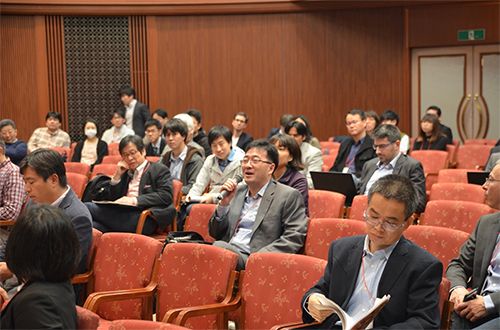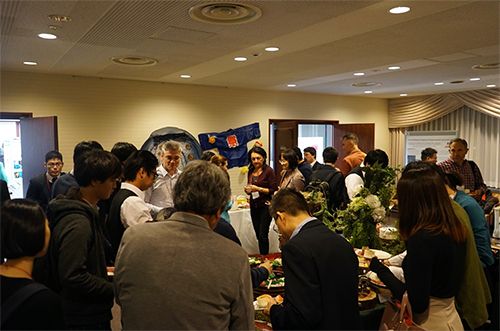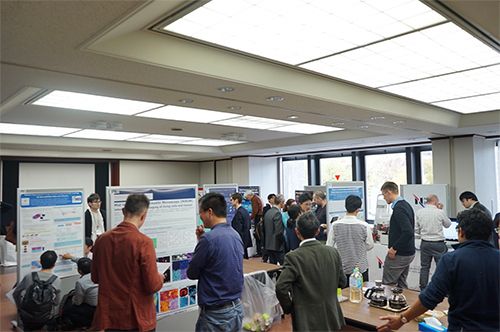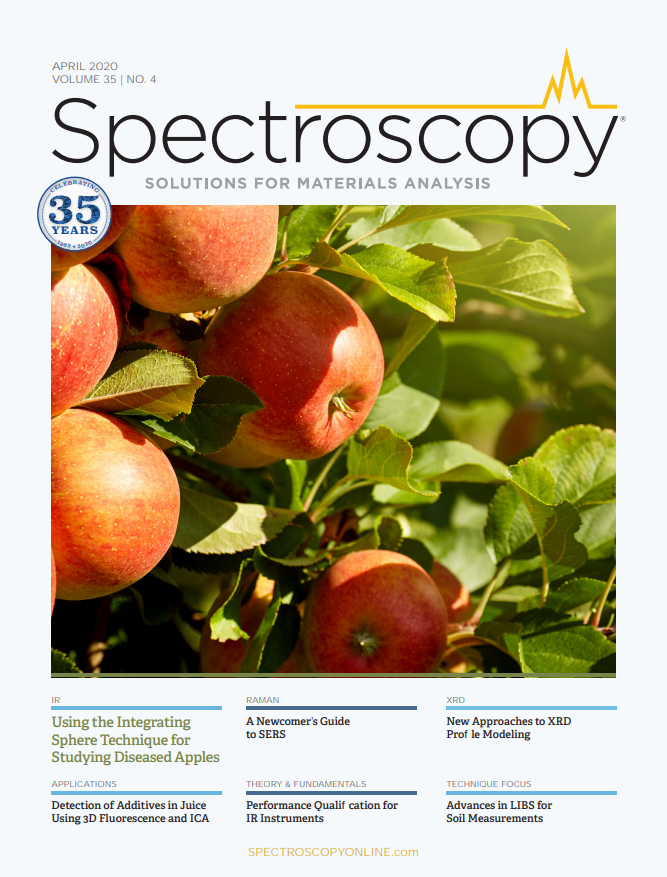Biomedical Raman Imaging 2019 in Osaka
Spectroscopy
Recent technical advances in biomedical Raman imaging pave a way to its application in the biomedical fields, where morphological information of samples provides rich information. A recent technical conference in Osaka, Japan, explored these developments.
Biomedical Raman Imaging 2019 (https://lasie.ap.eng.osaka-u.ac.jp/bri/) was held in Osaka, Japan, November 24–26, 2019. The symposium was aimed to discuss recent advances and technological developments in Raman imaging and its application in biological and medical research. In total, 129 participants gathered from Asia, Europe, and the United States and introduced their recent research progress and shared the perspectives on the research field. The technical program was accompanied by an exhibition that included 14 companies providing instruments and devices for Raman microscopy and spectroscopy and their application.
Raman spectroscopy has been utilized as a powerful technique for material analysis, but due to the low scattering efficiency of the technique, its contribution to the biomedical field has been limited. Recent technical development, especially those focused on imaging, pave a way to applications in biomedical fields, where morphological information of samples provides rich information. The imaging capability makes it possible to combine morphological and spectroscopical information to explore biological functions and causes of disease.
Biomedical Raman Imaging 2019, held in Osaka, Japan, November 24–26, 2019, was kicked off with a keynote talk by Ji-Xin Cheng from Boston University. He introduced the history of coherent Raman microscopy and his achievements in fast and analytical imaging of biological samples. In coherent Raman microscopy, two different wavelengths of laser are utilized to introduce the Raman effect efficiently through a stimulated transition of molecules to the vibrationally excited state. The enhancement of the signal can reach six orders of magnitude, which allows us to rapidly scan the sample by a focused laser to form a Raman image. Coherent Raman microscopy drastically boosts the light-to-signal conversion efficiency by exciting vibrational modes of interest selectively.
Figure 1: Participants and organizers of Biomedical Raman Imaging 2019 in Osaka.

On the other hand, techniques using spontaneous Raman scattering take different strategies. Because spontaneous Raman spectroscopy is performed with a simple illumination–detection scheme, the total signal can be easily boosted by parallel detection of Raman spectra. In Raman imaging, this advantage is utilized in the spatial multiplicity of Raman detection. Katsumasa Fujita introduced the parallel detection of Raman spectra from a sample irradiated by a line-shaped focus and improved the image acquisition speed for detecting the fingerprint and high-wavenumber region. Ioan Notingher of the University of Nottingham described a technique that uses a digital micromirror device (DMD) to obtain Raman spectra ever more efficiently. The advantage in the spatial multiplicity is given by the number of detection channels in a 2D sensor, which can easily achieve a signal enhancement of 106, however, the enhancement is practically limited by the intensity of the laser that can be incident to the sample.
Figure 2: Discussion during the symposium.

Hyperspectral Imaging
One of the advantages of Raman imaging is that it can provide rich information from a sample as a spectrum. In the symposium, there were also discussions about how to efficiently measure thousands of spectra to produce hyperspectral images of biological samples. Especially in coherent anti-Stokes Raman spectroscopy (CARS) and stimulated Raman scattering (SRS) microscopy, techniques for tuning pump or probe wavelength have been developed for the rapid acquisition of SRS or CARS spectra. Yasuyuki Ozeki of the University of Tokyo presented his achievement of rapid wavelength switching using fiber laser and amplification technologies. Spectrum focusing is another technique recently utilized to obtain hyperspectral images in coherent Raman microscopy, where two chirped pulsed lasers realize selective excitation of the vibrational state with a spectral resolution higher than the bandwidth of the laser. Paola Borri of Cardiff University and Ji-Xin Cheng have fully utilized this technique to perform various biomedical applications with CARS and SRS.
Marcus Cicerone of Georgia Institute of Technology presented his achievement in broadband Raman imaging and provided the comparison of different hyperspectral imaging techniques. The advancement of this coherent Raman technique is associated with the development of laser and detector technologies. Hideaki Kano of Tsukuba University reported broadband CARS microscopy with improved spectral resolution using a nanosecond laser source and supercontinuum, to produce multimodal label-free imaging of cells combined with second harmonic generation (SHG) imaging and third harmonic generation (THG) microscopy.
With spontaneous Raman spectroscopy, the spectrum is generated by irradiating a single-frequency laser, however, the low Raman scattering cross-section has always hindered rapid image acquisition. This issue has been overcome by the parallel detection of spectra from hundreds to a thousand points in a sample. Fujita pointed out that the efficiency of parallel detection is simply proportional to the number of pixels on a detector, which reaches more than 106 when using current 2D sensor arrays. Cicerone also mentioned that the difference between coherent and spontaneous Raman microscopy becomes small when a wide spectrum range is measured.
Raman Tags
The use of Raman tags was another topic discussed in many presentations. Although Raman spectroscopy is a label-free technique, its combination with labeling techniques provides innovative approaches to biomedical imaging. In Raman tag imaging, a small molecular structure, such as an alkyne, is used as a tag for target molecules. Raman tags can be used to label small molecules that cannot be labeled by bulky fluorescent probes that may alter the property of target molecules. Mikiko Sodeoka, of the RIKEN research institute in Japan, summarized her achievements in Raman tag imaging, including the first demonstration of alkyne tag imaging and applications to drug, lipid, and organelle imaging. Duncan Graham of the University of Strathclyde and Fujita also discussed the application of alkyne tag imaging in intracellular drug detection with improved sensitivity in SRS microscopy and spontaneous Raman microscopy, respectively.
The narrow-band emission is another advantage of the Raman tag. The spectrum width of the Raman tag is ten times smaller than that of fluorescence emission. Wei Min of Columbia University utilized this advantage for super multiplexed imaging of intracellular structures with SRS microscopy. By combining pre-resonant excitation, he successfully improved the signal strength and achieved a greater detection sensitivity. The use of the resonance effect usually requires a relatively large tag, but the capability of multiplexed imaging is useful in many areas of biological and medical research when combined with the power of labeling techniques developed for fluorescence microscopy.
The carbon-deuterium (CD) stretching vibration can also be detected separated from the endogenous molecules by Raman scattering. Lingyan Shi of the University of California, San Diego, reported the use of CD stretching vibration for observation of metabolism in animals. Supplying heavy water to animals, newly synthesized protein, lipid, nucleic acid containing CD vibrations can be observed by SRS microscopy. Narrow emission of luminescence can be combined with Raman imaging. Tao Wu of the Czech Academy of Sciences introduced the use of lanthanide, which provides a narrow band emission at the silent region, for counterstaining cellular structures. The lanthanide probe helps to interpret the Raman spectrum in a sample by highlighting the sample structures.
Biomedical Applications
The capability of label-free imaging is one of the advantages of Raman imaging methods. During the symposium, there were several reports on implementing Raman microscopy techniques in biomedical diagnosis. Jürgen Popp of the Leibniz Institute of Photonic Technology introduced his group’s long-time efforts to develop a portable coherent Raman imaging system that can be carried into an operating room. The system was realized by a compact fiber laser system that solved a practical bottleneck of the technique. Ji-Xin Cheng developed a handheld coherent Raman imaging system that can be easily operated by a medical doctor during an operation. Mariko Egawa of the Shiseido Global Innovation Center provided several examples of coherent Raman imaging in skin diagnosis and discussed the advantage for studies of cosmetics.
The combination of Raman imaging with endoscopy is also a promising approach to implement Raman spectroscopy as a diagnostic technique in the clinic, especially combined with robotic surgery. Mamoru Hashimoto of Hokkaido University introduced his group’s recent development of CARS endoscopy using a gradient index (GRIN) lens for image guiding, which can be implemented with such a surgical system. Hervé Rigneault of Institut Fresnel, CNRS, described a technique using a hollow-core fiber that can scan a focused laser in a small region in a body. Hirohiko Niioka of Osaka University introduced the use of a computational technique to obtain clear images with short exposure time, which provides feasibility for the technique for practical applications.
Cytometry is another direction for utilizing the analytical power of Raman spectroscopy. By combining cytometry with fast imaging using coherent Raman microscopy, large numbers of cells can be analyzed in a short time. Ji-Xin Cheng and Yasuyuki Ozeki presented their recent achievements in coherent Raman cytometry. When utilized with spectral analysis techniques, Raman cytometry can provide many possibilities in cell analysis, such as cell evaluation in medical diagnosis, regenerative medicine, and pharmaceutical studies. Ozeki presented flow cytometry based on fast SRS imaging. Nicholas Smith of Osaka University presented the combination of quantitative phase imaging and spontaneous Raman imaging, which enables rapid diagnosis of cells by using morphological and molecular information provided by optical phase and Raman imaging, providing both the benefits from imaging speed and the powerful analytical power of spontaneous Raman spectroscopy.
“The Future of Raman Imaging.” Mixer during the evening event, “The Future of Raman Imaging.”

Spectrum Analysis
As mentioned above, the spectrum analysis technique is a key element for applying Raman imaging for many biomedical applications. The spectrum contains a large amount of information described as data points in multi-dimensional space, and extracting the information is crucial for practical use. Typically, multivariate analysis, such as principal component analysis and clustering analysis, is utilized, and the adaptation of the techniques for each application has to be performed. Alison Hobro of Osaka University presented a result of extracting spectral components that reflect intracellular components changing with immune response in living macrophage cells. Tamiki Komatsuzaki of Hokkaido University introduced an approach that can merge information analysis and optical measurement to improve the speed of cell and tissue diagnosis dramatically, where the results of spectral analysis are fed back to the measurement condition in real time, allowing an intelligent spectrum measurement for rapid diagnosis. Thomas Bocklitz of the Leibniz Institute of Photonics Technology emphasized the importance of gathering high-quality data together with measurement conditions and information about instruments. The format for such metadata has not been defined, but it is in high demand for practical use of Raman spectra in most applications. The use of machine learning can be one way to mitigate the technical and practical problems, however, this work has just started and we need more experience in technology development and application.
Figure 4: Poster session and exhibition.

Future of Raman Imaging
Raman microscopy is a new modality for biomedical imaging and benefits from the new developments for other optical imaging techniques. Wei Min demonstrated 3D SRS imaging of deep tissue using a tissue clearing technique, enabling a 10-fold increase of depth penetration. Zhiwei Huang of the National University of Singapore described his new approaches for achieving super-resolution in coherent Raman imaging. Several new efforts to improve the speed and signal, such as a technique using Fourier-transform spectroscopy, were also discussed.
During the symposium, a panel discussion entitled “The Future of Raman Imaging” was also held. Rachel Won of the journal Nature Photonics and Rita Strack of the journal Nature Methods also joined the panelists and provided perspectives from broader aspects of the related science and technologies. We discussed current issues of Raman imaging techniques and requirements for shaping the many areas of potential of the technique into “real” biomedical applications.
Defining a data format, as mentioned above, and standard procedures to certify the reliability of the measurement, are also needed. To do this, it would be necessary to have a core facility where different Raman imaging techniques, equipment for biomedical studies, and data analysis are available for interdisciplinary collaboration.
Conclusion
The two-and-half day symposium gave us a strong impression of the advance of Raman imaging technology and the expectation for biomedical applications that provide new approaches for making the invisible visible. The symposium was co-chaired by Eiichi Tamiya and Katsumasa Fujita of Osaka University and the Advanced Institute of Science and Technology (AIST) and Prabhat Verma of Osaka University.
This wonderful symposium was made possible by support from AIST-Osaka University Advanced Photonics and Biosensing Open Innovation Laboratory (PhotoBIO-OIL), JSPS Core-to-Core Program, Photonics Center in Osaka University, and The Spectroscopical Society of Japan, along with the sponsors. The chairs also thank the international steering committee, Duncan Graham, Wei Min, Jürgen Popp, and Nicholas Smith, for their contribution to gather the excellent speakers and the enthusiastic participants. We are preparing a special issue in Analyst, a journal from the Royal Society of Chemistry, and have started planning the next symposium.
Katsumasa Fujita is with the Department of Applied Physics at Osaka University, in Osaka, Japan. Direct correspondence to: fujita@ap.eng.osaka-u.ac.jp

AI-Powered SERS Spectroscopy Breakthrough Boosts Safety of Medicinal Food Products
April 16th 2025A new deep learning-enhanced spectroscopic platform—SERSome—developed by researchers in China and Finland, identifies medicinal and edible homologs (MEHs) with 98% accuracy. This innovation could revolutionize safety and quality control in the growing MEH market.
New Raman Spectroscopy Method Enhances Real-Time Monitoring Across Fermentation Processes
April 15th 2025Researchers at Delft University of Technology have developed a novel method using single compound spectra to enhance the transferability and accuracy of Raman spectroscopy models for real-time fermentation monitoring.
Nanometer-Scale Studies Using Tip Enhanced Raman Spectroscopy
February 8th 2013Volker Deckert, the winner of the 2013 Charles Mann Award, is advancing the use of tip enhanced Raman spectroscopy (TERS) to push the lateral resolution of vibrational spectroscopy well below the Abbe limit, to achieve single-molecule sensitivity. Because the tip can be moved with sub-nanometer precision, structural information with unmatched spatial resolution can be achieved without the need of specific labels.